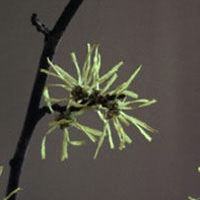Penn Herb Wellness Guide
Witch HazelFind Products
 © Steven Foster
© Steven FosterParts Used & Where Grown
Although native to North America, witch hazel now also grows in Europe. The leaves and bark of the tree are used in herbal medicine.
- Reliable and relatively consistent scientific data showing a substantial health benefit.
- Contradictory, insufficient, or preliminary studies suggesting a health benefit or minimal health benefit.
- For an herb, supported by traditional use but minimal or no scientific evidence. For a supplement,little scientific support.
Our proprietary “Star-Rating” system was developed to help you easily understand the amount of scientific support behind each supplement in relation to a specific health condition. While there is no way to predict whether a vitamin, mineral, or herb will successfully treat or prevent associated health conditions, our unique ratings tell you how well these supplements are understood by the medical community, and whether studies have found them to be effective for other people.
For over a decade, our team has combed through thousands of research articles published in reputable journals. To help you make educated decisions, and to better understand controversial or confusing supplements, our medical experts have digested the science into these three easy-to-follow ratings. We hope this provides you with a helpful resource to make informed decisions towards your health and well-being.
This supplement has been used in connection with the following health conditions:
| Used for | Amount | Why |
|---|---|---|
Cold Sores | Apply a cream containing 2% extract six times daily for three to eight days | Witch hazel has been shown in one study to reduce the size of cold sores and the spread of inflammation. |
Eczema | Apply 10 to 20% herbal extract two to three times per day | A cream prepared with witch hazel and phosphatidylcholine has been shown to be effective in the topical management of eczema. |
Hemorrhoids | Follow label instructions | Frequently applying a product that contains witch hazel, an astringent herb, may help reduce symptoms. |
Canker Sores | Refer to label instructions | Witch hazel is an astringent herb that can be used as a mouth rinse to soothe the pain of canker sores. The herb contains tannins that can bind up fluids and possibly relieve inflammation. |
Crohn’s Disease | Refer to label instructions | Witch hazel is a tannin-containing herb that may be helpful to decrease diarrhea during acute flare-ups and has been used for this purpose in traditional medicine. |
Menorrhagia | Refer to label instructions | Astringent herbs such as witch hazel have been traditionally used for heavy menstruation. |
Varicose Veins | Refer to label instructions | Witch hazel may be applied topically to treat varicose veins. |
Wound Healing | Refer to label instructions | Witch hazel can be used topically to decrease inflammation and to stop bleeding. |
Traditional Use (May Not Be Supported by Scientific Studies)
Native Americans used poultices of witch hazel leaves and bark to treat hemorrhoids, wounds, painful tumors, insect bites, and skin ulcers.1
Copyright 2025 TraceGains, Inc. All rights reserved.
Learn more about TraceGains, the company.
The information presented by TraceGains is for informational purposes only. It is based on scientific studies (human, animal, or in vitro), clinical experience, or traditional usage as cited in each article. The results reported may not necessarily occur in all individuals. Self-treatment is not recommended for life-threatening conditions that require medical treatment under a doctor's care. For many of the conditions discussed, treatment with prescription or over the counter medication is also available. Consult your doctor, practitioner, and/or pharmacist for any health problem and before using any supplements or before making any changes in prescribed medications. Information expires December 2025.


